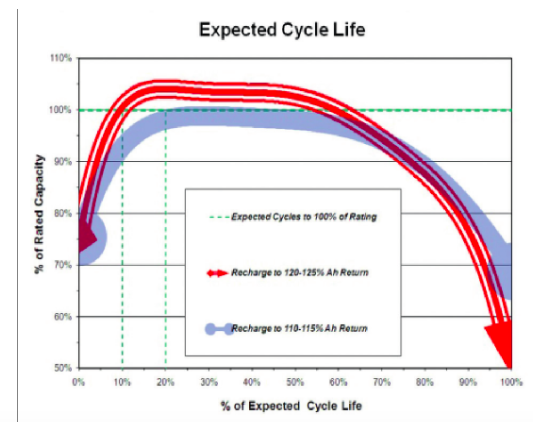When it comes time to purchase or replace the deep-cycle batteries in your golf car, there are a variety of factors that determine the overall performance and life you can expect to get out of them. Everyone knows that deep-cycle batteries are designed to provide continuous power over an extended period of time and are then recharged in preparation for the next discharge/recharge cycle. A brand new set of batteries, however, are not at 100% performance when you first put them in. Flooded lead-acid deep cycle batteries are designed to reach their rated and/or peak capacity after a conditioning period of capacity ‘cycle-up’.
This cycle-up period consists of a series of discharge/recharge cycles in normal operation during which the available battery capacity increases with each cycle. This conditioning cycle-up period is designed to provide the optimum in cycle life vs cost for this type of battery and application. The number of cycles required to achieve rated and/or peak capacity depends on many factors including but not limited to battery design, recharge method, depth of discharge, temperature, etc.
Most deep cycle battery manufacturers provide a ‘Capacity Development Curve’ that describes the relationship of initial capacity and the number of cycles required to achieve rated and/or peak capacity for this type of battery. The test procedures used to determine battery capacity ratings and capacity development relationships are specified in Battery Council International procedure BCIS-05 BCI Specifications for Electric Vehicle Batteries (Rev. 2010-15). Per BCIS-05: “Long-life deep cycle EV batteries typically exhibit 75-80% of rated capacity on initial discharge, full rated capacity within the first 100 cycles, and >100% of rating at peak capacity.”
This can be confusing to the average golf car owner, or to a fleet manager looking to minimize the initial purchase costs involved in replacing many batteries. Purchasing the lowest cost battery available isn’t always best for longevity or overall performance. Likewise, the most expensive battery may be underutilized and not necessarily the best value for your application.
To achieve optimum cycle life vs battery acquisition cost, most battery manufacturers recommend sizing the battery’s capacity to ~50% depth of discharge (DOD). This not only optimizes the cycle life of the battery vs cost, but also provides a ‘reserve’ capacity in situations where additional runtime is needed beyond normal requirements. Since flooded lead-acid deep cycle batteries can continue to deliver useable capacity down to ~50% of rated capacity, this recommendation also allows utilization of the total number of cycles available from the battery. For these reasons, the fact that this type of battery does not deliver full rated capacity ‘out-of-the-box’ is not usually an issue and can easily be managed through proper battery sizing and choice of battery type and manufacturer.
Battery manufacturers do recognize that golf car fleets may desire the highest possible capacity over the life of the battery. Accordingly, they are constantly improving battery designs and charging methods to achieve the highest possible initial capacity and the fastest possible cycle-up without compromising overall cycle life. For more information on deep-cycle batteries, visit www.usbattery.com.


























